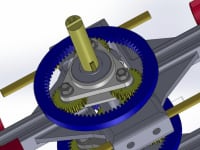Four cylinder IC engine with NO crankshaft.
The principal BENEFIT of a Scotch Yolk mechanism as used in an IC engine is to provide a piston with a connecting rod attachment that nearly eliminates the piston skirt and cylinder scuffing caused by the angular thrust between the piston and cylinder wall. However, as traditionally used, this mechanism is plagued by sliding friction and high contact pressures associated with the yolk design. The attached video is of a proof-of-concept prototype engine design that eliminates this rapid wear.
The base engine concept is that of a pair of common-axis, two cylinder modules incorporating the cylinders, cylinder heads and pistons of four Kawasaki 340 engines. By using a number of commercially available spur gears and bearings, a block with a 2.0-in. stroke was designed to operate with the 2.36-in. bore of the donor engines.
Three planetary gear-sets, with the annulus gears held stationary, are each connected by two needle bearing supported links to an opposing pair of planet gear-sets. These two LINKS together with the center planetary gear-set function as the engine's CRANKSHAFT and each also carry a pair of low friction linear bearings that travel along shafts fixed to the CONNECTING ROD. The reciprocating motion of each ROD is further defined by four linear bearings traveling on parallel shafts fixed to the engine block.
A seal, surrounding the center planetary gear-sets, prevents crankcase air pressure from leaking between the two common-axis cylinders. This center gear-set contains two ports that allow the flow of fuel, air and oil mixture to diagonally opposite pistons (1 and 4) traveling upward on the compression stroke. One-half revolution later the same ports are now open to flows to the diagonally opposite pistons (2 and 3). Primary and secondary dynamic balance is achieved without the addition of any parasitic weights.
This mechanism allows the purely linear motion of the pistons/connecting rods to be converted to rotary motion by keying one or both output drive shafts to its associated planet carrier to provide one revolution of the output shaft for every cycle of the pistons.
Alternatively, one shaft could be keyed to its associated sun gear to provide a step-up drive in the ratio of annulus gear teeth to sun gear teeth. In this configuration the shaft could drive a supercharger or generator or to assist a turbocharger.
Northwind Engineering, Inc.
Cedarburg, WI 53012
USA
Mike Trost (Engineer)
Randy Tetzlaff (Designer)
Video
Like this entry?
-
About the Entrant
- Name:Mike Trost
- Type of entry:teamTeam members:Mike Trost (Engineer), Randy Tetzlaff (Designer)
- Patent status:none








